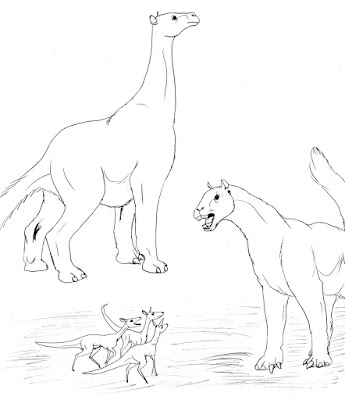
Giant Armadillo

Pink Fairy Armadillo
While the smaller armadillos can roll into a tight ball when attacked and defend it's self effectively against all but the biggest predators, the larger armadillos cannot. Though they are also equipped with the sharp claws of their modern counterparts to slash at predators with, a lot of the larger armadillos of the Metazoic also have sharp edges on the armor or spikes. In Grammoclavia, they have sharp, scissor-like plates that stick out on the sides, they use this to crush or tear any predators that may attack. Unlike other armadillos, Grammoclavia is not stiff anywhere in the body, they are very flexible. The placement of the body plates allows these armadillos to turn into a U-turn or touch their feet with their nose if they have to. These animals even have a saw-like structure of the armor on the tail. The plates are sharp, thin and triangular, and they can swash their tail at an attacker and those razor-sharp blades on the tail can rip the flesh of a predator, even disembowel it! To top it off, Grammoclavia is also equipped with a blunt club at the end of the tail to enable it to stun the predator with sharp blows. Few predators will attack this armadillo. The only predators they really have to worry about is Deinognathus, which are virtually undetered by Grammoclavia's defenses. Dasyventris is the largest armadillo of all time. Their armor is a bit less extensive than that of Grammoclavia, but they are big and tough animals that are built like tanks! The armor on the back has a series of rows of short, sharp, conical spikes. Just behind the head is 6 sets of sharp horns. The armor on the tail consists of tough plates and at the end of the tail is a set of 4 very sharp spikes they use to swat at predators. All this is in addition to the 4 sharp, curved claws they have on the front feet. It is a very well-armored animal, that you would think would be safe from all predators. The only true predators of this armadillo is Deinognathus, who are ingenius enough to figure out how to by-pass that armor and get to the animal's soft belly, it's most vulnerable spot.
The armadillos tomorrow, like today, are found only in the New World. One species of Dasypus has even made it's way pretty far into North America. In my own opinion, they will continue to migrate further until they reach Canada. These are not listed on my checklist as of yet, but these "fluffy armadillos" will have thick fur underneath and a hard shell on top, with small ears, long noses, large eyes, and will hibernate during winter months. They may even get larger than most species of Dasypus. Larger animals exist better in the cooler climates. These will probably be the bears of the Metazoic.
All armadillos are omnivorous. The smaller species feed primarily on invertebrates. This includes insects, snails, earthworms, etc. The larger species can feed on any of these plus more. The largest species are opportunists, and feed mostly on insects, invertebrates, amphibians, other small vertebrates and carrion. Armadillos are not chasers, so their conquering of small vertebrates is mostly the slower-moving animals such as flightless birds, small rodents, even smaller armadillos. They will even scavenge the kills of such animals as the viverrids, and even smaller deinognathids that they can intimidate off their kills.
Anyone who wants to read about the armadillos of the future, here is the link once again: http://www.metazoica.com/armadillos.html



